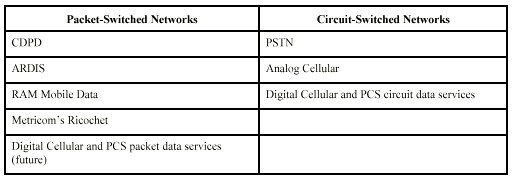|
Circuit-switched Vs. Packet-switched connections |
Data can be transmitted across networks using either circuit-switched or packet-switched connections. Each type of connection has unique characteristics and appropriate uses.
Circuit-switched connections provide a temporary dedicated line, or circuit, between two endpoints. Dedicated implies that the circuit is not shared with any other users; temporary implies that the connection exists only for the duration of the transmission. A telephone voice connection is an example of a circuit-switched connection. A circuit is dedicated from the moment the caller dials a phone number and makes a connection until the caller and receiver hang up. Once the connection is terminated, the circuit becomes available for use by other parties.
Circuit-switched connections are appropriate for voice calls that tend to be long, two-way, and highly interactive. This makes circuit-switched connections appropriate for data transactions that share similar characteristics. For example, an extended file transfer that requires the use of a network connection for a long period of time would be appropriate for a circuit-switched connection.
When transferring data via a circuit-switched connection, all data is transferred at once from the source to the destination. Data is received in the order sent and is not likely to be lost, separated, or incomplete.
Circuit-switched networks generally interconnect with the Public Switched Telephone Network (PSTN). Because circuit-switched connections involve dedicated circuits, a connection can take some time to establish. For instance, a modem connection might take from 10 to 40 seconds to establish, depending on modem protocols, compatibility of modems, and other factors. Charges for circuit-switched connections are based on the duration of the connection as well as the distance between calling parties.
In contrast to circuit-switched connections, packet-switched connections do not use a dedicated circuit between two endpoints. Rather, packet-switched connections allow multiple simultaneous users access to multiple locations across a network. Packets (packages of data) are sent from source to destination using the quickest route available. While circuit-switched connections operate the same as a phone call, packet-switched connections are much like sending a series of post cards through the mail.
Because each packet contains a source and destination address, packets that make up a single transaction can be sent out of order and along different routes through the network. A packet from one user might immediately be followed by a packet from another user. Although packets theoretically can be of any size, typical user data packet sizes range from 100 to 1500 bytes.

Transmitting information in packets can result in vastly increased efficiency and reduced costs to users. And because packet-switched networks generally interconnect with Public Data Networks (PDNs), a variety of new communication services are available to users.
CDPD, RAM Mobile Data, ARDIS, and Metricom’s Ricochet are packet-switched networks. All packet-switched services require a special line from the customer site to the access point of the packet-switched network or a connection via the Internet.. Charges for packet-switched network services are usually based on the number of packets or the amount of data communicated—the length of time over which communications occur is immaterial. A computing device could have an open connection to the network for an entire day and charges would be incurred only for the data transmitted.
Because packet-switched networks offer rapid connections and charges are based on volume of data, they are particularly well-suited for transaction-based applications and transmissions involving short, “bursty” messages. Credit card authorization, database querying, and dispatching are good examples of packet-switched applications.
Table 1 categorizes the networks discussed in this paper by circuit-switched or packet-switched communications.

| Send comments to webmaster Copyright © 1997 Derek Mc Donnell. All Rights Reserved. Last updated 07-Apr-1998. |
 |